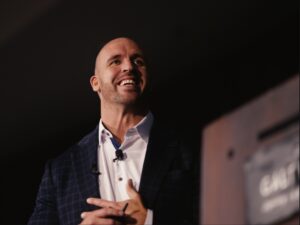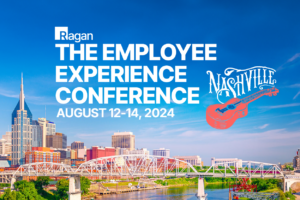Managing difficult conversations about mental health at work
Shutterfly VP of Comms Jennifer George shares how she helps destigmatize mental health in the workplace.

“My accent comes out after a glass or two of wine,” said native Bostonian Jennifer George, VP of Communications and Public Relations at Shutterfly. Since her career took off, however, she’s called multiple countries home.
Her journey started in China, where she consulted for small and medium-sized businesses, something that George said showed her “the power of what comms can do.” Afterwards, she volunteered at a school in Kenya for young girls who had been rescued from child marriages. “I got to see firsthand how climate change was impacting the plight of women and girls,” said George. “It kicked off a professional passion of mine for ESG.”
It’s not George’s only passion: In addition to being the executive sponsor of Shutterfly’s mental health employee resource group (ERG), she’s the former global director of communications at Headspace, the mental health and meditation app. “I cannot speak more highly of the importance of having a good support network,” said George.
Ahead of her session at Ragan’s upcoming Employee Communications and Culture Conference, George shared her favorite TED talk, her best advice to managers seeking to implement mindfulness practices with their direct reports, and why she’s made it her mission to destigmatize mental health in the workplace.
Communication has truly been at the center of all aspects of your life. Your passions have really grown from your lived experience.
George: At first when you’re up and coming in your career, you think you have to bifurcate everything: “This is the professional me; and this is the personal me.” The truth is, there’s no such thing.
That’s at the core of one of the causes of burnout, though, that lack of separation from work and home that came out of being at home during the pandemic.
When lockdown first started, I was running PR for Headspace. And I was so overwhelmed. It was a peak moment for people who were looking for mental health support — we were partnering with Governor Cuomo in New York, Governor Whitmer in Michigan, we were making new fresh content and trying to make it available for free to as many communities and audiences we could.
I remember one moment, it was a Saturday night. I was on the phone with Governor Cuomo’s press secretary. And we were preparing for one of his upcoming press conferences.
I was holed up in the bathroom on the phone, trying to have this personal call. My two-and-a-half-year-old was banging on the door trying to get in, and I’ve got my foot against the door, and I’m trying to hold it together.
I’m not alone in those stories of desperation. You just suddenly realize there’s no way you can balance [your way out of] this.
I’m the executive sponsor of our mental health ERG here at Shutterfly. I’ve struggled with mental health myself, which I talk about very openly, because there’s still a huge stigma around it.
How did you walk back from that? What allowed you to re-center yourself after that moment in the bathroom with your foot against the door?
When COVID first started, I figured it’s going be a couple of weeks, things will go back to normal… like everyone else thought. I was already struggling a bit with my mental health because of postpartum anxiety [my daughter was born in mid-2019]. And after about a month, which was right around the time [of the bathroom incident], there was a moment where I was trying to make dinner and the kids were crying, and I was getting more calls.
I just slumped on the kitchen floor. I texted my therapist, and we had a session that night. And since then, every Friday at 1 pm, my calendar is blocked and my team knows that it’s blocked, because I’m talking to [my therapist].
You would go to the hospital for a broken arm. Your mind needs help just the same way. Mental health is physical health. I saw it in that moment when I physically could not get up.
How do you recognize when your fellow employees get to that moment? Do you have any advice for handling those delicate conversations?
I make it a real point to talk very openly about my own mental health. But I also ask questions: How are you doing? Is there anything that I can take off your plate? Can I help you reprioritize? Opening [the door] to that conversation is the first step.
Shutterfly has a very heavy quarter 4; a lot of holiday cards, gifts, school photographs. It’s often very hard for people to take time off. Every quarter 4 I require people to put in at least a week, if not more, into our [group] calendar. People know that their work is going to be taken care of, and they are encouraged to take that time off [without stress].
I send notes. World Mental Health Day, Stress Awareness Month. [Sometimes] I’ll also send a list of resources. Andy Puddicombe’s TED talk is a great one to just rewatch. There’s also The Motherhood Center. A lot of folks in communications are women and mothers. From my own experience, it can be really challenging struggling with mental health, but also trying to take care of your child.
Of course, we have our employee assistance programs, but [I think beyond that] to other options, like [therapy app] BetterHelp. We have access to Sanvello [a mindfulness app] as part of our benefits. Find different ways to check in.
We also set up a 15-minute block on the team’s calendar, about 18 people, every single day. It’s a mindful moment. It’s meant to [allow you] to take a little bit of time, take a walk, meditate or just make something part of your routine.
There has also been a generational shift in how people look at work. There are people who have never stepped foot in an office, that had been working at home for years.
The workforce is facing a massive amount of burnout and stress and loneliness. The pandemic certainly supercharged it, but the macro-economic environment is exacerbating it. You’ve got increased stressors as it relates to geopolitical turmoil in Ukraine, Russia, what’s happening in Israel. All of these things together are creating a really complex place for our minds.
[My first consideration] is helping to reduce the stigma around [mental health], whether it’s bringing in a speaker or resiliency workshops.
The other piece is just around preventative care. How are we proactively monitoring our workforces and evaluating [our] employees’ mental health? We’ve done wellbeing surveys to get a pulse on how our people are faring right now. How is their workload? Are they accessing the tools on a regular basis? The preventative care piece is really important to help stave off some of that burnout and fatigue.
The third piece is around having the courage to start a conversation [at the top, because you really do set the tone as a leader. There is something about showing care and grace for our people that is so profound.
And that doesn’t take any budget or resources. It just takes [us being able to] wrap our arms around our people in a way that only HR and communicators can do so beautifully.
Join George at Ragan’s Employee Communications and Culture Conference on April 25-27. George will speak alongside communications leaders from Kraft Heinz, US Bank, Motorola, Constellation, and more.






